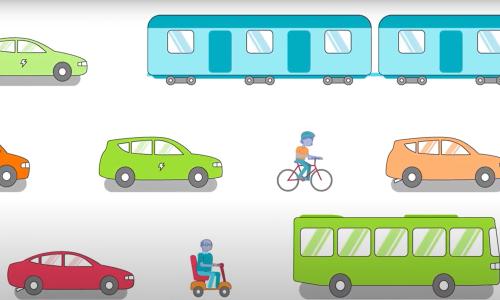As California transitions to a transportation system powered by clean electricity, it must phase out the existing supply chain for petroleum fuels in an orderly process—one that protects communities, workers, and consumers.
The transition offers an opportunity not only to reduce pollution dramatically but also to invest in communities harmed by the production and use of fossil fuels.
But only careful planning and new policies will ensure that the oil industry does not exploit the transition to evade its responsibilities to workers and communities or unfairly profit from reduced competition in the fuel marketplace.
A Petroleum Phaseout Plan for California
This is an online version of the fact sheet. The full fact sheet can be downloaded here.
California has set its sights on phasing out fossil fuels, and it is making significant progress. Gasoline demand has peaked and is now declining as drivers choose electric vehicles and as the efficiency of gasoline vehicles improves (Reichmuth 2024). While a complete phaseout of fossil fuels for the transportation sector will take decades to achieve, it is essential for meeting California’s climate and air pollution goals.
Replacing fossil fuels requires a massive scaleup of renewable energy, electric vehicles, public transit, and other strategies to help people get around rather than always needing to drive. The flip side of scaling up clean energy solutions is the need to phase out polluting fossil fuels in a clean, safe, and fair manner.
Petroleum infrastructure runs throughout California. Oil wells, pipelines, refineries, storage tanks, and gas stations are polluting air, soil, and water. Their operation harms people everywhere, and this is especially the case in communities near the refineries that produce gasoline and diesel fuels and the highways where cars and trucks burn those fuels.
Moreover, much of California’s petroleum infrastructure is decades old, having evolved gradually over the last century. It has been around so long that most people stop noticing it, assuming that it is inevitable. But in the coming decades, most of that infrastructure will become obsolete and unnecessary. Phasing it out offers great opportunities even as it also comes with significant challenges. Both must be addressed to achieve a clean, safe, and fair future, free of fossil fuels.
Opportunities
A Transportation System Without Fossil Fuel Pollution
California’s transportation sector accounts for about 50 percent of the state’s greenhouse gas emissions, nearly 80 percent of nitrogen oxide pollution, and 90 percent of diesel particulatematter pollution (CEC n.d.a). The resulting harm falls disproportionately on communities of color and low-income communities, the people who live and work in proximity to highways, ports, and other concentrated sources of vehicle pollution (Reichmuth 2019). Phasing out petroleum and replacing it with a transportation system powered by renewable electricity will help address longstanding and inequitable public health harms.
Rebuilding Communities Long Harmed by Refineries and Other Petroleum Infrastructure
For generations, communities near oil refineries, oil wells, and other parts of the petroleum infrastructure have borne the brunt of pollution and harm, and that burden has fallen disproportionately on Black, Brown, Indigenous, and poor communities (Donaghy et al. 2023; Pinto de Moura 2024). As the industry contracts and ultimately phases out entirely, the state must hold polluters accountable for cleaning up their facilities and leaving them safe for future use. Just as important is investing in economic revitalization in communities now overburdened by pollution.
In the processes of envisioning a cleaner future, communities must be the leaders. Further, they must be supported as they build economies independent of fossil fuels, including the creation of new sources of good jobs and a local tax base to replace what is lost in the transition.
Challenges
Oil Companies Cannot be Trusted to Protect Communities, Workers, or Consumers
From the local to the global level, the dangerous, even deadly, practices of oil companies are well documented. From leaded gasoline to global warming, oil companies have concealed and misled the public and policymakers about the harm their products cause both to health and to the stability of the global climate (Bannerjee et al. 2015; Coll 2013, JCC 2024; Kovarik 2021; Mulvey and Shulman 2015). Meanwhile, the major oil companies continue to rake in huge profits.
Nor do the challenges end when oil companies shut their facilities. The 2019 closure of the largest refinery on the East Coast has provided valuable lessons in how oil companies, in planning for an exit, will strive to shed their obligations to workers and put workers and communities further at risk—and then declare bankruptcy and walk away after a century of profits and pollution (Simeone 2023). Rather than let bankruptcy courts decide the future of refinery communities, policymakers must listen to the voices of those most affected and prepare for the inevitable in ways that enable communities to shape their own post-fossil fuel futures.
California's Petroleum Infrastructure Is Not Set Up to Operate at Reduced and Steadily Declining Scales
Scaling down gasoline production will be a complex process requiring careful planning and oversight to avoid major disruptions. As gasoline consumption falls, so, too, will the utilization of oil refineries, pipelines, and other parts of the infrastructure to produce and distribute gasoline. Operating at reduced scale will be less profitable so some facilities will shut down or go bankrupt. Even today, only nine refineries in California produce gasoline, so the closure of just one can have a big impact on production. The largest refinery in Northern California accounts for 45 percent of that region’s refining capacity; in Southern California the largest refinery accounts for 35 percent of capacity (CEC 2024).
With so few facilities accounting for such a large share of production, an unexpected closure could leave the state with inadequate refining capacity. Moreover, California uses a unique cleaner-burning formulation of gasoline and lacks pipeline connections to other regions. As a result, it operates as a “fuel island” and cannot readily increase imports to compensate for reduced in-state production.
A Shrinking Petroleum Industry Could Reduce Competition, Increasing the Risk of Price Spikes and Anticompetitive Behavior
Five companies control 98 percent of the production capacity for California gasoline (CEC 2024). Within two decades, just a single operating refinery could remain in at least one of the state’s major fuel markets. That company would have market power unprecedented since the breakup of the Standard Oil Trust more than a century ago. However, the trust’s dissolution was intended to create multiple companies and make the fuel marketplace more competitive; today, new companies may hesitate to enter a market in terminal decline.
In 2023, concerns about abuse of the industry’s growing market power led the California legislature to give the California Energy Commission new authorities and responsibilities for reporting and assessment. The same legislation created an independent Division of Petroleum Market Oversight with responsibility for oversight and investigation (CEC n.d.b). The state should use this authority both to address short-term problems in the gasoline market and also to evaluate, anticipate, and address emerging challenges to the broader fuel system
The Path Forward
Plan to Put People's Needs Ahead of Oil Industry Profits
Phasing out fossil fuels and replacing them with renewable energy is essential to meeting California’s pollution and climate goals (UCS n.d.). The transition from gasoline to electric cars is well underway. The market share for zero-emissions vehicles in California surpassed 20 percent in 2023, and gas consumption is falling after a century of growth (Reichmuth 2024).
Yet even with rapid growth in electric vehicle sales, it will be decades until the last gasoline cars leave the road, and completing the phaseout of petroleum will proceed at different paces for diesel, jet fuel, and many other products. Moreover, the production of gasoline is just part of a complex web that involves extraction, transportation, refining multiple fuels and other products, and fuel storage and distribution. Unravelling this web, while providing reliable and affordable access to fuel for people who rely upon it, is a complicated task, made more difficult by the oil industry’s recalcitrant behavior.
California has created new regulatory authorities and a planning process at the California Energy Commission and other state agencies, and these are starting to address the transition from petroleum to cleaner energy (CEC 2024b). This planning process must be informed by the communities and workers with the most at stake, and the resulting actions must protect the health and safety of all Californians and support an equitable transition to clean transportation.
Update the Rules to Protect Workers, Communities, and Consumers
A changing fuel landscape requires new rules. The current regulatory framework rests on assumptions that are quickly becoming obsolete: that most people get around in gasoline-powered cars; that oil refineries and other infrastructure are here to stay; that the market for producing and selling gasoline and other petroleum products is stable and competitive and can be regulated as such. But the California fuel market will be profoundly transformed in the coming decades in unprecedented and hard-to-predict ways. The rules must keep pace to protect workers whose jobs are at stake, communities facing major transitions, and consumers who need reliable, affordable access to transportation, whether via gasoline-powered cars, electric vehicles, public transportation, or bicycles.
California legislators and regulators have enacted new rules, but these are just the start. It will be a long process to ensure that the phaseout of petroleum seizes the important opportunities in the transition to a clean transportation system, addresses key challenges, and puts the health and welfare of people ahead of oil-company profits.
Jeremy Martin is the director of Fuels Policy and a Senior Scientist in the UCS Clean Transportation Program.
This is an online version of the fact sheet. The full fact sheet can be downloaded here.
Downloads
Citation
Martin, Jeremy. 2024. "A Petroleum Phaseout Plan for California: Charting a Path to Clean Transportation." Cambridge, MA: Union of Concerned Scientists. https://doi.org/10.47923/2024.15640



